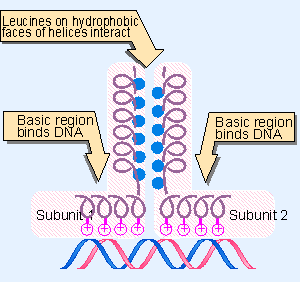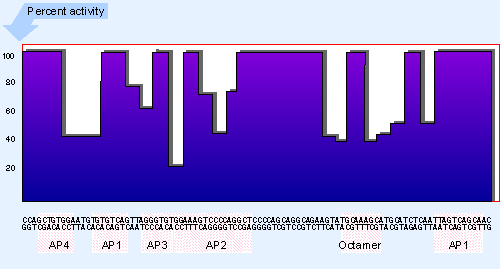8. Leucine zippers are involved in dimer formation
21.8 Leucine zippers are involved in dimer formation |
 |
Figure 21.15 The basic regions of the bZIP motif are held together by the dimerization at the adjacent zipper region when the hydrophobic faces of two leucine zippers interact in parallel orientation. |
Interactions between proteins are a common theme in building a transcription complex, and a motif found in several transcription factors (and other proteins) is involved in both homo- and heteromeric interactions. The leucine zipper is a stretch of amino acids rich in leucine residues that provide a dimerization motif. Dimer formation itself has emerged as a common principle in the action of proteins that recognize specific DNA sequences, and in the case of the leucine zipper, its relationship to DNA binding is especially clear, because we can see how dimerization juxtaposes the DNA-binding regions of each subunit. The reaction is depicted diagrammatically in Figure 21.15 (Landschulz et al., 1988).
An amphipathic α-helix has a structure in which the hydrophobic groups (including leucine) face one side, while charged groups face the other side. A leucine zipper forms an amphipathic helix in which the leucines of the zipper on one protein could protrude from the α-helix and interdigitate with the leucines of the zipper of another protein in parallel to form a coiled coil. The two right-handed helices wind around each other, with 3.5 residues per turn, so the pattern repeats integrally every 7 residues.
How is this structure related to DNA binding? The region adjacent to the leucine repeats is highly basic in each of the zipper proteins, and could comprise a DNA-binding site. The two leucine zippers in effect form a Y-shaped structure, in which the zippers comprise the stem, and the two basic regions bifurcate symmetrically to form the arms that bind to DNA. This is known as the bZIP structural motif. It explains why the target sequences for such proteins are inverted repeats with no separation (Vinson et al., 1989).
Zippers may be used to sponsor formation of homodimers or heterodimers. They are lengthy motifs. Leucine occupies every seventh residue in the potential zipper. There are 4 repeats in the protein C/EBP (a factor that binds as a dimer to both the CAAT box and the SV40 core enhancer), and 5 repeats in the factors Jun and Fos (which form the heterodimeric transcription factor, AP1).
 |
Figure 20.19 An enhancer contains several structural motifs. The histogram plots the effect of all mutations that reduce enhancer function to <75% of wild type. Binding sites for proteins are indicated below the histogram. |
AP1 was originally identified by its binding to a DNA sequence in the SV40 enhancer (see Figure 20.19). The active preparation of AP1 includes several polypeptides. A major component is Jun, the product of the gene c-jun, which was identified by its relationship with the oncogene v-jun carried by an avian sarcoma virus (see 28 Oncogenes and cancer). The mouse genome contains a family of related genes, c-jun (the original isolate) and junB and junD (identified by sequence homology with jun). There are considerable sequence similarities in the three Jun proteins; they have leucine zippers that can interact to form homodimers or heterodimers.
The other major component of AP1 is the product of another gene with an oncogenic counterpart. The c-fos gene is the cellular homologue to the oncogene v-fos carried by a murine sarcoma virus. Expression of c-fos activates genes whose promoters or enhancers possess an AP1 target site. The c-fos product is a nuclear phosphoprotein that is one of a group of proteins. The others are described as Fos-related antigens (FRA); they constitute a family of Fos-like proteins.
Fos also has a leucine zipper. Fos cannot form homodimers, but can form a heterodimer with Jun. A leucine zipper in each protein is required for the reaction. The ability to form dimers is a crucial part of the interaction of these factors with DNA. Fos cannot by itself bind to DNA, possibly because of its failure to form a dimer. But the Jun-Fos heterodimer can bind to DNA with same target specificity as the Jun-Jun dimer; and this heterodimer binds to the AP1 site with an affinity ~10 that of the Jun homodimer.
| Research | |
| Landschulz, W. H., Johnson, P. F., and McKnight, S. L. (1988). The leucine zipper: a hypothetical structure common to a new class of DNA binding proteins. Science 240, 1759-1764. | |
| Vinson, C. R., Sigler, P. B., and McKnight, S. L. (1989). Scissors-grip model for DNA recognition by a family of leucine zipper proteins. Science 246, 911-916. | |